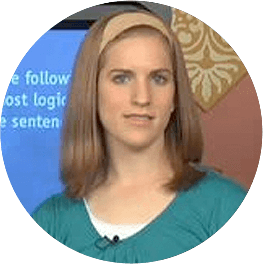
Case Western Univ., summa cum laude
Perfect scorer on the SAT & the ACT
Devorah is the founder of Advantage Point Test Prep and the author of the book “Boost Your Score” The Unofficial Guide to the Real ACT.
I should be working but you caught me catching up some on some celebrity gossip. Now unfortunately the reading passages just aren't as exciting as Lindsay Lohan's latest shenanigans but the more you know about them, the easier they'll be to tackle on test day. In this episode we're going to talk about a few things. First of all the instructions for the reading section, then we'll cover the format of the reading section and then we'll talk about the passage types.
It's really important to know about the instructions and format ahead of time. So let's take a look at the instructions and format of the reading section. Here are the instructions: On this test you will have 35 minutes to read four passages and answer 40 questions (ten questions per passage). Each set of ten questions appears directly after the relevant passage. You should select the answer choice that best answers the question. There is no time limit for work on the individual passages, so you can move freely between the passage and refer to each passage as often as you'd like. Let's talk about the length of the passages. Each of the passages is about 750 words long and if you're trying to get an idea of how long that is, that's about the length of a People Magazine article. Now sadly, these passages are not that entertaining but they're the same length as what you would see in People or just some magazine like that.
Each passage is followed by ten questions of mixed difficulty and there are 35 minutes for 40 questions and four passages. Think for a second about how crazy that is, 35 minutes to read four really long, really boring passages and then answer 10 questions on each one. So on reading, pacing and practice is everything. Make sure to watch episodes that we've got about things like pacing, how to best prepare, reading the passages, we have really good strategies for how to answer the questions, how to guess but in this episode we're just going to do a quick overview of the passages and the question types you'll see on the reading section.
所以我们谈过,你有四个段落nd the cool thing about reading is that they'll always show up in the same exact order. You've always got prose fiction, then social science, then humanities and then natural science each time. This will get really important when we talk about pacing later. It's cool to know that they're always in the same order and you'll know what to expect. Prose fiction by the way is the only fiction passage you'll see on the test. So prose is actually in my opinion the most interesting one. It kind of feels like you're just sitting around reading a book. It's just an excerpt from a novel or maybe a short story and the passage is usually focused on plot and characters and the corresponding questions will also be things about the plot, the character, you know character development, interaction between the characters, narrator bias, questions like that and we'll delve into that later in our episode about answering the questions. Social science is the next passage, these are usually informative writing on a variety of subjects things like psychology, political science, history, government, topics like that and passages focused on analysis. The questions on these passages usually ask things like; cause and effect, comparing and contrasting between maybe theories you'll see, chronology, if there is something historical presented, what order it came in and again we'll look at those more closely later. Next passage type, humanities and these are usually excerpts from memoirs, personal essays, these are those artsy ones that you'll see maybe if they're about art or music, theater, topics like that and the passages are expository or descriptive. So usually they're not as analytical as social science, they're usually just describing something just neutrally talking about it. Questions on these are a lot like the questions you'll see on social science, chronology questions, you know what came first, what came next, cause and effect, if one thing caused another thing, questions like that. Last, we have natural science, these are about scientific arguments or experiments, really sciency topics maybe sometimes you've got evolution, why something became extinct, topics like that and they explore the reasoning and the significance for just different scientific topics. Questions also on this passage tend to ask about cause and effect is a biggy and sometimes conflicts between theories that scientists are presenting.
Let's wrap this up. In this episode we talked about instructions and format. We talked about how you'll always have your four passages, 750 words long with ten questions attached to each of the passages. We also talked about how those four passages, really predictable, always in the same order. You'll always have your prose, then your social science, then your humanities and then your natural science. So that's it for this episode, remember that on the reading section pacing is everything, so please make sure to watch the other episodes where we'll talk about some great pacing strategies and we'll talk about some great strategies for marking up your passage and for answering the question.